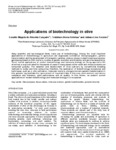Use este identificador para citar ou linkar para este item:
http://www.alice.cnptia.embrapa.br/alice/handle/doc/951890Registro completo de metadados
| Campo DC | Valor | Idioma |
|---|---|---|
| dc.contributor.author | CANÇADO, G. M. de A. | pt_BR |
| dc.contributor.author | SETOTAW, T. A. | pt_BR |
| dc.contributor.author | FERREIRA, J. L. | pt_BR |
| dc.date.accessioned | 2013-03-01T11:11:11Z | pt_BR |
| dc.date.available | 2013-03-01T11:11:11Z | pt_BR |
| dc.date.created | 2013-03-01 | pt_BR |
| dc.date.issued | 2013 | pt_BR |
| dc.identifier.citation | African Journal of Biotechnology, Nairobi, v. 12, n. 8, p. 767-779, Feb. 2013. | pt_BR |
| dc.identifier.uri | http://www.alice.cnptia.embrapa.br/alice/handle/doc/951890 | pt_BR |
| dc.description | Many scientific and technological fields make use of biotechnology. Among the most important applications of biotechnology in agriculture are large-scale commercial micropropagation, genetic transformation and the development of transgenic varieties, embryo rescue in plant breeding programs, genotyping based on DNA markers, studies of genetic evolution and diversity, and genome sequencing. These myriad applications of modern biotechnology and molecular biology are being applied to the olive tree, a crop cultivated for thousands of years in many places of the world and whose products are consumed globally. The selection and development of olive cultivars by conventional breeding methods is costly and time consuming, therefore, the application of biotechnology procedures and techniques, such as in vitro cultivation, molecular markers, and genomic and genetic transformation in this species may facilitate the improvement of important traits of this crop, such as biotic and abiotic resistance and tolerance, yield performance and oil quality. In this review, we present current applications of modern biotechnology and molecular biology in olive species. | pt_BR |
| dc.language.iso | por | pt_BR |
| dc.rights | openAccess | pt_BR |
| dc.title | Applications of biotechnology in olive. | pt_BR |
| dc.type | Artigo de periódico | pt_BR |
| dc.date.updated | 2013-06-24T11:11:11Z | pt_BR |
| dc.subject.thesagro | Azeitona | pt_BR |
| dc.subject.thesagro | Marcador molecular | pt_BR |
| dc.subject.thesagro | Cultura de tecido | pt_BR |
| riaa.ainfo.id | 951890 | pt_BR |
| riaa.ainfo.lastupdate | 2013-06-24 | pt_BR |
| dc.identifier.doi | 10.5897/AJBX12.015 | pt_BR |
| dc.contributor.institution | Geraldo Magela de Almeida Cançado, EPAMIG; Tesfahun Alemu Setotaw, EPAMIG; JULIANO LINO FERREIRA, CPPSUL. | pt_BR |
| Aparece nas coleções: | Artigo em periódico indexado (CPPSUL)  | |
Arquivos associados a este item:
| Arquivo | Descrição | Tamanho | Formato | |
|---|---|---|---|---|
| FerreiraCancadoetal13.pdf | 477,41 kB | Adobe PDF |  Visualizar/Abrir |









